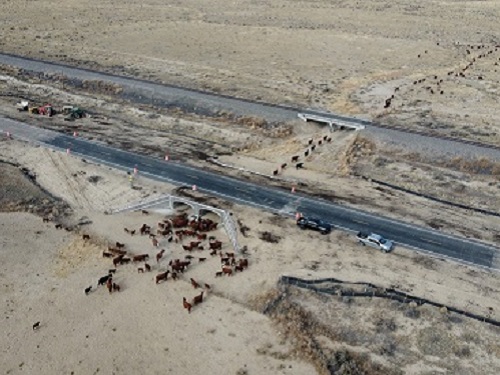The U.S. Department of Transportation recently began what it calls a “first-of-its-kind” pilot program to prevent wildlife-vehicle collisions and improve habitat connectivity.
[Above photo by the Colorado DOT]
Created and funded by the $1.2 trillion Infrastructure Investment and Jobs Act or IIJA enacted in November 2021, that pilot program – dubbed the “Wildlife Crossings Pilot Program” and managed by the Federal Highway Administration – will make grant funding available to states and communities to construct wildlife crossings over or below busy roads, add warning signs for drivers, acquire mapping and tracking tools, and more.
FHWA is making a total of $350 million available over five years, including more than $111 million in grants through its first round of funding in 2023. The agency also noted that roughly 200 people are killed – and many more are injured – annually in the United States in more than one million collisions involving wildlife and vehicles.
“There are proven practices to prevent crashes between vehicles and wildlife, and with this investment, we’re going to take commonsense steps to reduce collisions and make roads safer for rural and urban communities alike,”FHWA Administrator Shailen Bhatt said in a statement.
“Communities that may not previously have had access to funding for these critical projects can finally make roads safer while protecting wildlife and their movement corridors,” he added.
FHWA noted that grants are available for all wildlife-vehicle collision prevention activities, including but not limited to research, planning, design, and construction.
The agency added that it seeks to award funds for both non-construction and construction projects via the new program, including research on safety innovations, mapping and tracking tools, and the design and construction of overpasses and underpasses.
A recent blog post by the Pew Trusts highlights how the growing success of wildlife crossings – bridges, underpasses, and culverts designed to help animals avoid vehicle traffic – across the U.S. is drawing a surge of interest from policymakers seeking to reduce wildlife-vehicle collisions and protect animals.
Meanwhile, state departments of transportation have already been working on a variety of wildlife-vehicle collision prevention initiatives over the last several years.
For example, to date, Colorado DOT said it has built more than 60 wildlife mitigation structures crossing above or under highways throughout the state. Additionally, it has installed 400 miles of high big game fencing along state and U.S. highways or next to the interstates.
In August 2022, the agency completed a wildlife overpass and underpass on U.S. Highway 160 in the southwestern part of the state; a stretch of road where more than 60 percent of all crashes are due to wildlife-vehicle collisions.
In April 2022, the Oregon Department of Transportation received a special one-time allocation of $7 million in general funds from the Oregon legislature to invest in wildlife corridor projects statewide.
The Oregon DOT said it has had “great success” with wildlife undercrossing structures in recent years, with five crossings built to date in the state, all on U.S. 97, leading to an 86 percent reduction in wildlife-vehicle collisions.
Concurrently, a research document released in July 2022 by an international pool funded study led by the Nevada Department of Transportation provides an “authoritative review” of the most effective measures to reduce animal-vehicle collisions, improve motorist safety, and build safer wildlife crossings.

